The Iran National Jewels Museum, one of Tehran’s notable museums, is situated in the Central Bank building, showcasing valuable jewelry from past centuries, royal gifts, and belongings to the public. In this blog post in Parsi Tours Iran travel Agency we will explore the extraordinary and wonderful artifacts of Persian heritage during past millennia.
Why Visit the Iran National Jewels Museum?
- The museum houses items adorned with precious gems such as diamonds and pearls.
- Notably, the Iran National Jewels Museum is home to the world’s largest pink diamond, the Darya-ye Noor diamond.
- If you have an interest in unique jewelry and gold designs, a visit to this museum is highly recommended.
- The National Jewels Treasury contains a collection of the most valuable and precious jewels, not only in the country but also in the world.
- Considering these remarkable features, it can be confidently stated that the Iran National Jewels Museum ranks among the most important places to visit in Iran.
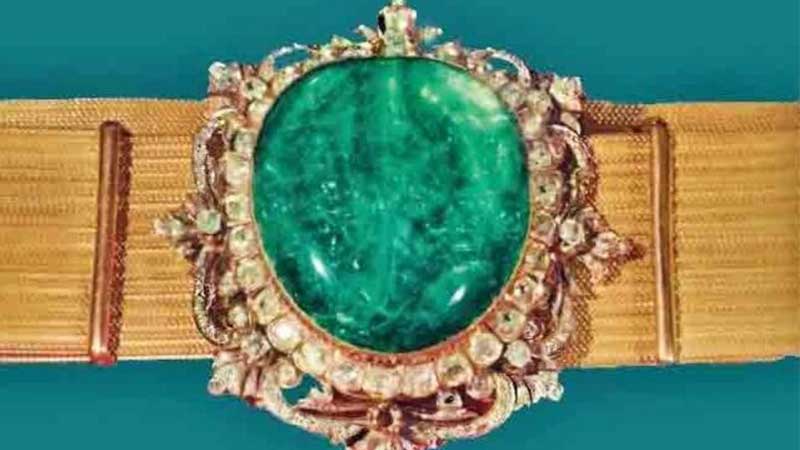
History of the Iran National Jewels Museum
After enduring the instabilities of history, many outstanding works and precious stones found their way to the treasury of the National Bank of Iran in 1937. With the completion of the current treasury building in 1955, the Central Bank was established, and in 1960, the responsibility for protecting and maintaining these jewels was entrusted to the Central Bank. These jewels are mentioned in historical accounts and even legends, and they have had varied fates in different historical periods.
As history recounts, the Safavid kings were the first to acquire precious gems from India, France, Britain, and the Ottoman Empire, amassing this treasure. However, after the plundering of this treasure, Nader Shah embarked on a mission to India to reclaim these jewels, along with a substantial amount of loot. Nader Shah offered a significant portion of this treasure to the Holy Shrine of Razavi, as well as to rulers, commanders, and soldiers.
Subsequently, due to the looting by Ahmad Bey Afghan, a gem like the Koh-e Noor diamond was lost forever and eventually ended up in the possession of Queen Victoria. The Qajar and Pahlavi eras witnessed carefree days for national treasures, during which many works were created to showcase precious stones as unparalleled decorations. Notably, two gems in this treasury, one turquoise extracted from the Neishabur mines and the other a pearl from the Persian Gulf, have been added in recent years.
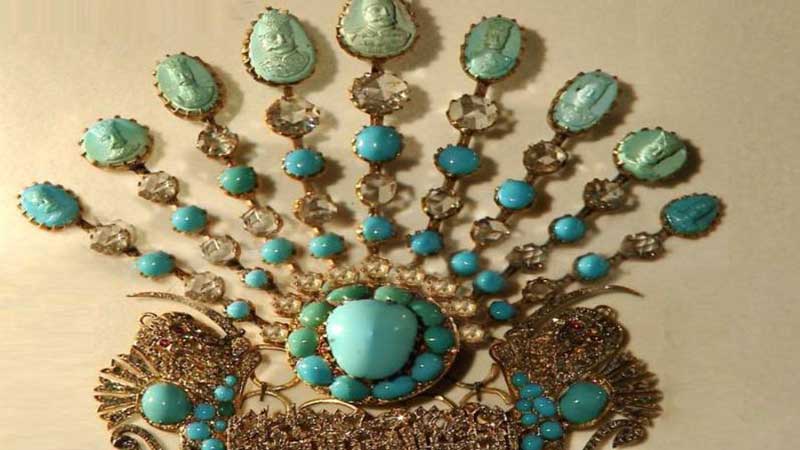
Tips for Visiting the Tehran Jewels Museum
Keep in mind that upon entering the Royal Jewels Museum, bringing a camera or mobile phone is prohibited, so photography of the collection is not possible. Additionally, entry to the museum is only allowed for individuals aged 12 and older. Upon arriving at the Istanbul intersection and seeing the Central Bank building, head toward the small door located at the top of the building’s stairs. The security guard will guide you to the exhibition halls.
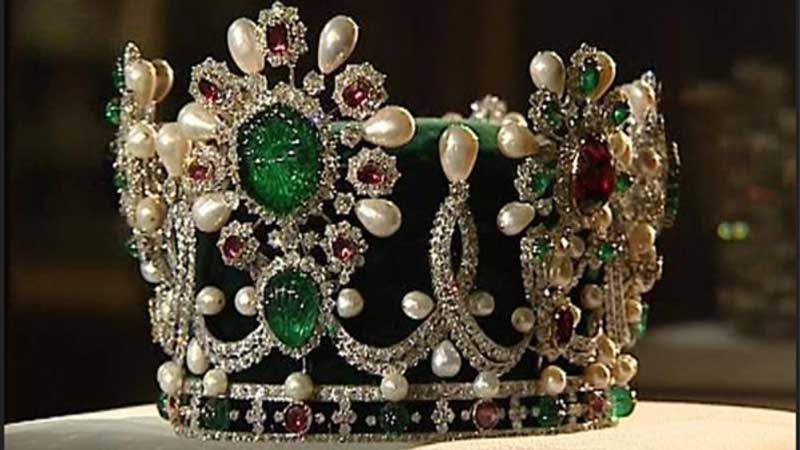
What Can Be Explored at Iran National Jewels Museum?
The National Jewelry’s treasures extend beyond their economic worth; they not only reflect Iran’s ancient culture and history but also evoke the artistic sensibilities of long-gone times. This exquisite collection comprises gems that are unparalleled worldwide, with their true and estimated values remaining incalculable. These gems and jewels are organized into 37 rooms, encompassing crowns, half-crowns, necklaces, ornaments, vases, candlesticks, parasols, food covers, daggers, swords, shields, and various other objects and artworks.
Takht-e Tavoos
One of the museum’s unique pieces that captivates visitors from the outset is the Takht-e Tavoos, or Peacock Bed, commissioned by Fath-Ali Shah Qajar. This gilded wooden bed is embellished with royal gemstones and crafted by Qajar-era artisans. Takht-e Tavoos serves as a magnificent representation of luxurious Iranian art. The flat wooden frame showcases the exceptional craftsmanship of Qajar artists, featuring intricate floral motifs and elaborate carvings that highlight the artisans’ skill. The wood undergoes meticulous processing, covered in layers of gold leaf, enhancing its overall allure.
However, what truly enchants viewers is the collection of precious stones adorning the peacock bed. Meticulously selected for their beauty and rarity, these gemstones include diamonds, rubies, emeralds, and sapphires. They are intricately arranged on the bed, creating a breathtaking display of colors. The gemstones’ brilliant hues contrast beautifully with the golden backdrop, making the peacock bed an utterly unique spectacle.
Symbolically, peacock motifs represent immortality and royalty. Renowned for its magical feathers, the peacock has long been associated with regal power and beauty. The incorporation of peacock motifs in the design of the peacock bed underscores the magnificence and authority of the Qajar dynasty. When visitors to Tehran behold the Takht Tavoos, they are transported to the glory and majesty of Iran’s past. This masterpiece stands as a testimony to Iran’s rich artistic heritage and showcases the unique talents of the Qajar craftsmen who crafted it. The peacock bed is a true gem of the Iran National Jewels Museum.
Darya-ye Noor Diamond
The most magnificent gem housed in the Iran National Jewels Museum is the pink Darya-ye Noor diamond, weighing 182 carats and ranking among the world’s largest diamonds. Its rarity lies in its unique pink color, and it is steeped in legends and myths. During Naser al-Din Shah’s reign, a pink diamond adorned one of his royal armbands. Later, it was placed on a crown encircled by 457 diamonds and 4 rubies. The distinct color of the Darya-ye Noor evokes the ethereal glow of the sea, setting it apart from other diamonds. Darya-ye Noor, also known as the Sea of Light Diamond is a true marvel of nature, symbolizing beauty and elegance. Its extraordinary size and mesmerizing pink hue make it a rare treasure in the realm of diamonds.
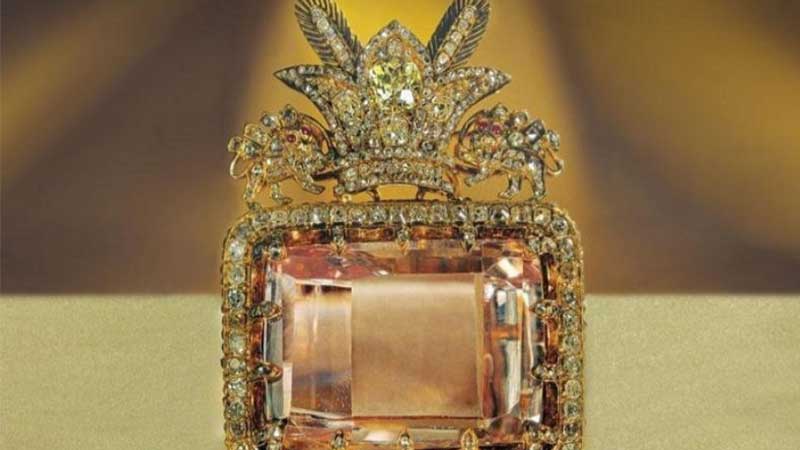
Darya-ye Noor Diamond
The Sea of Light Diamond is cut on both sides, and all its surfaces are smooth and uniform. One side bears the inscription “Sultan Sahebqaran Fath-Ali Shah Qajar 1244.” It is believed that Iranians bestowed the name Darya-ye Noor upon it when Nader Shah Afshar invaded India, bringing the Darya-ye Noor diamond along with other precious objects such as Koh-e Noor (Mountain of Light Diamond) and Noor Al Ain. Indeed, even the naming of Koh-e Noor is attributed to Nader Shah, who, upon seeing the diamond for the first time, was said to have exclaimed, “A mountain of light!”
In 1642 AD, Jean-Baptiste Tavernier had the privilege of closely inspecting the diamond that would later be known as the Sea of Light Diamond. This diamond once graced the throne of the Mughal emperor. It is believed that the Darya-ye Noor diamond originated from the Golconda mines in India and remained in the possession of the Mughal emperors until 1739 AD.
Some argue that this diamond is far older, dating back to previous ruling dynasties in India. It is believed that the Kakatiya dynasty, which reigned from approximately 956 to 1323 AD, possessed this diamond. However, during the Khilji dynasty’s relatively brief rule from 1290 to 1320 AD, the Darya-ye Noor diamond was looted.
The clarity of the Sea of Light Diamond is exceptional, akin to a Golconda diamond. It has been described by Edwin Streeter as a magnificent jewel of unparalleled brilliance. This diamond is believed to be entirely pure and exceptionally clear, possessing the characteristics of the finest Golconda diamonds. Sir John Malcolm, who traveled to Iran in the early 19th century, had the rare opportunity to view the royal crown jewels, including the Darya-ye Noor Diamond. In his book “Sketches of Persia,” published in 1827 AD, he noted that the honorable Shah had shown him his most valuable jewels, including the Darya-ye Noor Diamond, considered one of the purest and most exceptional diamonds globally.

He added, “The Sea of Light Diamond, dating back to the 17th century, is not only one of the oldest pink diamonds globally but also the largest pink diamond ever discovered.” Both the Darya-ye Noor Diamond and the Noor Al Ain Diamond are believed to have been cut from the “Great Slab Diamond” and have held their distinction as the first and second-largest known pink diamonds worldwide since their historic crafting in the early 1800s.
Given the extreme rarity of pink diamonds of such size in nature, which usually weigh less than one carat and rarely range from one to 50 carats or more, the discovery of another diamond like the Sea of Light’s magnitude is highly unlikely.
Crowns and Half-Crowns
The Iran National Jewels Museum proudly exhibits a stunning collection of crowns and half-crowns from various historical periods, offering insight into the aesthetic tastes and artistic styles of the Iranian royal family. These regal headpieces symbolize glory and epitomize the majesty and authority of their respective epochs.
One exceptional example is the Taj-e Kiani or Kiani Crown, commissioned by Fath Ali Shah, showcasing the extraordinary artistry of the Qajar era. The Kiani crown stands as a true masterpiece adorned with a dazzling array of gemstones, including diamonds, emeralds, rubies, and pearls. Each gemstone has been meticulously chosen and expertly set, resulting in a breathtaking display of celestial splendor. The crown’s design features intricate flower and leaf motifs that underscore the artistic features of the Qajar era.
Another notable crown is the Pahlavi Crown, a symbol of the Pahlavi dynasty. This crown, crafted from precious metals such as gold and silver, serves as a witness to the skill and artistry of Iranian jewelers. Adorned with a profusion of diamonds, rubies, emeralds, and other precious stones, carefully arranged to create a regal and captivating effect, the Pahlavi Crown is renowned as a powerful symbol of Iran’s rich cultural heritage during the Pahlavi era.
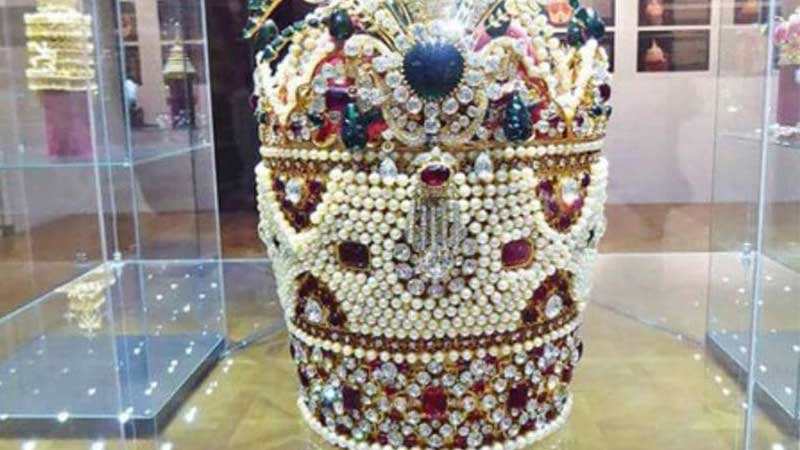
Additionally, the Iran National Jewelry Museum houses an impressive collection of half-tiaras, often worn by queens and princesses, and adorned with an array of precious stones, reflecting the refined taste and style of Iranian royalty. Each half-crown carries its own unique narrative, embodying the artistic trends and cultural influences of its era.
Among the half-crowns, the Noor Al Ain half-crown stands out, once worn by Queen Farah Pahlavi. Crafted by a renowned New York jeweler, this half-tiara features a portion of the exceptional Sea of Light Diamond as its centerpiece, surrounded by an exquisite arrangement of diamonds that radiates brilliance and elegance. Noor Al Ain represents the epitome of luxury and grace. As visitors embark on tours of Tehran and admire the works at the Iran National Jewelry Museum, they are transported to a different world. Each piece serves as a proof to Iran’s rich history and cultural heritage, offering glimpses into the magnificence and glory of the Iranian monarchy.
The Sphere of Jewels
One of the most remarkable features of the Iran National Jewelry Museum is The Sphere of Jewels, an awe-inspiring creation that ranks among the largest jeweled spheres ever crafted. This monumental sphere measures 66 cm in diameter and utilizes 34 kg of gold, along with 3,656 grams of precious gemstones. This sphere was commissioned by Nasereddin Shah, and it uniquely marks different geographical regions with distinct jewels.
In the Gemstone Globe, each region of the world is meticulously designated with various gemstones, representing the diversity of geographic features and cultural influences found across the globe. These gemstones have been carefully selected to mirror the colors and characteristics associated with each region. Diamonds may symbolize snowy mountain ranges, emeralds lush forests, rubies vibrant cities, and sapphires the seas.
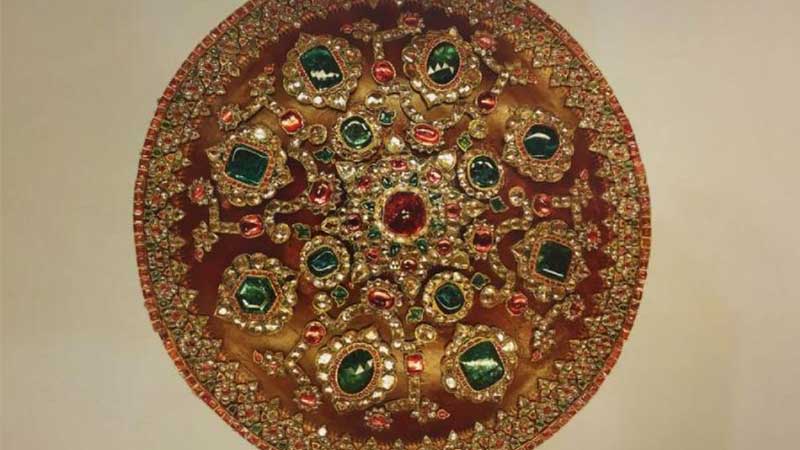
The Sphere of Jewels
The Sphere of Jewels serves as evidence to the extraordinary skill and craftsmanship of jewelers who carefully positioned each gemstone within this intricate world. The creation of such a masterpiece demanded precision, skill, and countless hours of meticulous work. Visitors who embark on tours and explore this museum are left in awe of the incredible artistry and attention to detail. This masterpiece embodies the spirit of exploration, cultural diversity, and global interconnectedness transcending borders. The Sphere of Jewels stands as a testimony to the creativity and ingenuity of its creators, displayed in the Iran National Jewels Museum as a reminder of the wonders of our world and the enduring beauty of precious stones.
Naderi Paisley and Throne
Among the fascinating artifacts at the Iran National Jewels Museum, visitors will encounter a rare paisley and throne, both of which hold significant symbolism in Iranian royalty and majesty.
Naderi Paisley is a jewel that features a large emerald at its center, surrounded by diamonds. This extraordinary piece is considered one of Iran’s most renowned and valuable jewels. Its unique design and exceptional gemstones make it a true masterpiece of jewelry art. Emeralds, known for their vibrant green color, captivate the eye with their mesmerizing beauty. The surrounding diamonds, expertly set in intricate patterns, further enhance the overall brilliance of the paisley.
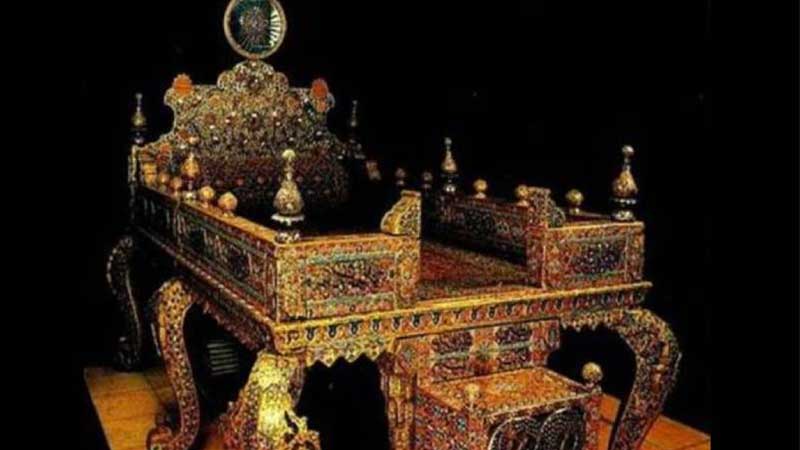
Naderi Paisley and Throne
Adjacent to Naderi Paisley, visitors will discover Takht-e Naderi, an astounding bed adorned with 22,000 precious stones, commissioned by Fath-Ali Shah. The bed’s intricate motifs, engravings, and symbols captivate viewers and represent the power, prestige, and magnificence of that era. The precious stones that embellish this rare bed add richness and elevate its regal aura.
Other Treasures
In addition to the aforementioned items, the Iran National Jewelry Museum of boasts an extensive collection of jewelry and objects adorned with precious stones, too numerous to list individually. It is intriguing to note that these jewels extend beyond the realm of crowns. Historically, nearly all royal accessories were adorned with precious stones. Some noteworthy pieces include:
- Food plates
- Jeweled jug and hookah
- Royal collars or helmets
- Perfume containers
- Candlesticks
- Swords and daggers
- Rare shield
- Pins and brooches
- Badges and medals
- Cape and hat
- Watches
- Jewelry boxes
- Curtain hangers
- Bejeweled sunbeds and basins
These exquisite treasures serve as exemplars of the glory and artistry of the royal court. They represent a diverse array of objects embellished with precious stones within the Iran National Jewels Museum. For those not residing in Tehran, joining last-minute tours can be an excellent way to visit these gems.
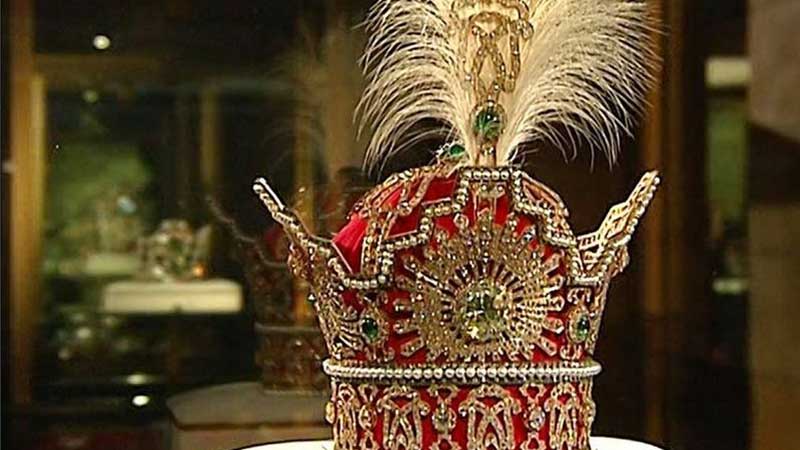
How to Reach the Iran National Jewelry Museum
The Iran National Jewels Museum’s central location in the city provides convenient accessibility. Nevertheless, due to the area’s location within a traffic-restricted zone, private car usage is not advisable. The nearest metro station to the museum is Saadi Station (Red Line 1), which is a mere 200 meters from the museum. The bus line from Jomhouri Square to Baharestan Square also passes through Istanbul intersection Station. Fortunately, many of Tehran’s attractions are situated in this vicinity.



